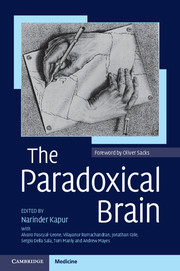Book contents
- Frontmatter
- Contents
- Acknowledgements
- Preface
- Foreword
- Author affiliations
- Abbreviations
- 1 The paradoxical nature of nature
- 2 Paradoxical effects of sensory loss
- 3 Paradoxical functional facilitation and recovery in neurological and psychiatric conditions
- 4 Paradoxes in neurorehabilitation
- 5 The paradoxical self
- 6 Paradoxical psychological functioning in early child development
- 7 Cognitive ageing: a positive perspective
- 8 Paradoxes of learning and memory
- 9 The paradox of human expertise: why experts get it wrong
- 10 Paradoxes in Parkinson's disease and other movement disorders
- 11 Paradoxical phenomena in epilepsy
- 12 Paradoxical creativity and adjustment in neurological conditions
- 13 Paradoxical functional facilitation with noninvasive brain stimulation
- 14 Unexpected benefits of allergies and cigarette smoking: two examples of paradox in neuroepidemiology
- 15 The paradox of autism: why does disability sometimes give rise to talent?
- 16 Paradoxes in creativity and psychiatric conditions
- 17 The paradox of psychosurgery to treat mental disorders
- 18 The paradox of electroconvulsive therapy
- 19 Paradoxes of comparative cognition
- 20 Paradoxical phenomena in brain plasticity
- 21 Immature neurons in the adult brain. Breaking all the rules
- 22 The paradoxical hippocampus: when forgetting helps learning
- 23 Paradoxical effects of drugs on cognitive function: the neuropsychopharmacology of the dopamine and other neurotransmitter systems
- 24 The paradoxical brain – so what?
- Index
- References
17 - The paradox of psychosurgery to treat mental disorders
Published online by Cambridge University Press: 05 December 2011
- Frontmatter
- Contents
- Acknowledgements
- Preface
- Foreword
- Author affiliations
- Abbreviations
- 1 The paradoxical nature of nature
- 2 Paradoxical effects of sensory loss
- 3 Paradoxical functional facilitation and recovery in neurological and psychiatric conditions
- 4 Paradoxes in neurorehabilitation
- 5 The paradoxical self
- 6 Paradoxical psychological functioning in early child development
- 7 Cognitive ageing: a positive perspective
- 8 Paradoxes of learning and memory
- 9 The paradox of human expertise: why experts get it wrong
- 10 Paradoxes in Parkinson's disease and other movement disorders
- 11 Paradoxical phenomena in epilepsy
- 12 Paradoxical creativity and adjustment in neurological conditions
- 13 Paradoxical functional facilitation with noninvasive brain stimulation
- 14 Unexpected benefits of allergies and cigarette smoking: two examples of paradox in neuroepidemiology
- 15 The paradox of autism: why does disability sometimes give rise to talent?
- 16 Paradoxes in creativity and psychiatric conditions
- 17 The paradox of psychosurgery to treat mental disorders
- 18 The paradox of electroconvulsive therapy
- 19 Paradoxes of comparative cognition
- 20 Paradoxical phenomena in brain plasticity
- 21 Immature neurons in the adult brain. Breaking all the rules
- 22 The paradoxical hippocampus: when forgetting helps learning
- 23 Paradoxical effects of drugs on cognitive function: the neuropsychopharmacology of the dopamine and other neurotransmitter systems
- 24 The paradoxical brain – so what?
- Index
- References
Summary
Summary
The creation of lesions in healthy brain tissue in order to treat psychiatric disorders is paradoxical in view of the frequent occurrence of psychiatric disorders after focal and diffuse brain lesions. Thus, the introduction of neurosurgery for psychiatric disorders, or psychosurgery, in the 1930s was seen as a bold, indeed desperate, attempt in the face of a therapeutic impasse. The rationale for psychosurgery was based on very modest evidence, and while the evidence base has grown in subsequent years, it remains a controversial treatment, limited in its scientific base and unable to shrug off the legacy of its early days of over-enthusiastic application. The recent introduction of neuromodulatory techniques, in particular deep brain stimulation, has altered the tone but not the nature of the debate, and better empirical evidence as well as theoretical rationale are necessary before the paradox underlying psychosurgery can be readily explained.
The history of paradoxical treatments in psychiatry
Psychiatric treatment is no stranger to paradoxes, and its history is littered with examples of counter-intuitive strategies, and bold attempts to heal the fractured mind. One ancient treatment that can be traced to prehistoric times is the practice of trepanation, or the creation of holes in the skull to treat diseases (Restak,2000). When performed for mental illnesses or epilepsy, the rationale was to permit malevolent spirits to escape the skull. The practice of seemingly antithetical treatments continued into the twentieth century, although the scientific grounding of some of these treatments had improved.
- Type
- Chapter
- Information
- The Paradoxical Brain , pp. 301 - 320Publisher: Cambridge University PressPrint publication year: 2011



